BDNF-Related Imbalance of Copine 6 and Synaptic Plasticity Markers Couples With Depression-Like Behavior and Immune Activation in CUMS Rats
- PMID: 30429764
- PMCID: PMC6220370
- DOI: 10.3389/fnins.2018.00731
BDNF-Related Imbalance of Copine 6 and Synaptic Plasticity Markers Couples With Depression-Like Behavior and Immune Activation in CUMS Rats
Abstract
Chronic stress is a contributing risk factor in the pathogenesis of depression. Although the mechanisms are multifaceted, the relationship can be ascribed partly to stress-related alterations in immune activation and brain plasticity. Considering the increasing evidence regarding the role of Copine 6 in the regulation of synaptic plasticity, the aim of the present study is to investigate Copine 6 expression in the hippocampus and the prefrontal cortex (PFC) in a stress-induced depression rat model. The behavior of the rats was evaluated via the open field test, saccharin preference test, elevated plus maze test, tail suspension test, Morris water maze, and forced swimming test. The plasma concentrations of C-reactive protein (CRP) and interleukin-6 (IL-6) were measured, and the protein expressions of brain-derived neurotrophic factor (BDNF), Copine 6, and synaptic plasticity markers in the hippocampus and the PFC were also detected. The results showed that chronic unpredictable mild stress (CUMS) induces depression-like behavior in rats, accompanied by increased plasma concentrations of CRP and IL-6. Moreover, the protein expressions of BDNF, Copine 6, and synapsin I were decreased in both the hippocampus and the PFC of CUMS rats, and the protein expression of synaptotagmin I was decreased in the hippocampus. Furthermore, Pearson's test revealed a potential relationship between the depression-like behavior, the plasma CRP concentration, and the protein expressions of BDNF, Copine 6, synapsin I, or synaptotagmin I in the hippocampus or the PFC. Together with our previous results, the current findings suggest that apart from immune activation, the BDNF-related imbalance of Copine 6 expression in the brain might play a crucial role in stress-associated depression-like behaviors and synaptic plasticity changes.
Keywords: BDNF; Copine 6; chronic unpredictable mild stress (CUMS); depression; saccharin preference; synapsin I; synaptotagmin I.
Figures


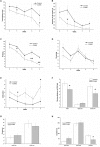
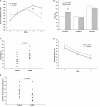
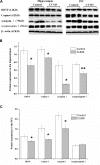
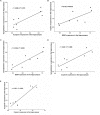
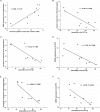
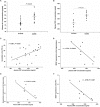
Similar articles
-
Quercetin Alleviates LPS-Induced Depression-Like Behavior in Rats via Regulating BDNF-Related Imbalance of Copine 6 and TREM1/2 in the Hippocampus and PFC.Front Pharmacol. 2020 Jan 17;10:1544. doi: 10.3389/fphar.2019.01544. eCollection 2019. Front Pharmacol. 2020. PMID: 32009956 Free PMC article.
-
Imbalance of leptin pathway and hypothalamus synaptic plasticity markers are associated with stress-induced depression in rats.Behav Brain Res. 2013 Jul 15;249:38-43. doi: 10.1016/j.bbr.2013.04.020. Epub 2013 Apr 22. Behav Brain Res. 2013. PMID: 23619134
-
[Correlation between Depressive Behavior and Expressions of S100β and Brain-derived Neurotrophic Factor in Hippocampus and Frontal Cortex of Rats].Zhongguo Yi Xue Ke Xue Yuan Xue Bao. 2020 Apr 28;42(2):209-215. doi: 10.3881/j.issn.1000-503X.11306. Zhongguo Yi Xue Ke Xue Yuan Xue Bao. 2020. PMID: 32385027 Chinese.
-
Impaired learning and memory in rats induced by a high-fat diet: Involvement with the imbalance of nesfatin-1 abundance and copine 6 expression.J Neuroendocrinol. 2017 Apr;29(4). doi: 10.1111/jne.12462. J Neuroendocrinol. 2017. PMID: 28211103
-
The Evidence for Altered BDNF Expression in the Brain of Rats Reared or Housed in Social Isolation: A Systematic Review.Front Behav Neurosci. 2017 May 31;11:101. doi: 10.3389/fnbeh.2017.00101. eCollection 2017. Front Behav Neurosci. 2017. PMID: 28620285 Free PMC article. Review.
Cited by
-
Quercetin Alleviates LPS-Induced Depression-Like Behavior in Rats via Regulating BDNF-Related Imbalance of Copine 6 and TREM1/2 in the Hippocampus and PFC.Front Pharmacol. 2020 Jan 17;10:1544. doi: 10.3389/fphar.2019.01544. eCollection 2019. Front Pharmacol. 2020. PMID: 32009956 Free PMC article.
-
Optimization of food deprivation and sucrose preference test in SD rat model undergoing chronic unpredictable mild stress.Animal Model Exp Med. 2020 Mar 31;3(1):69-78. doi: 10.1002/ame2.12107. eCollection 2020 Mar. Animal Model Exp Med. 2020. PMID: 32318662 Free PMC article.
-
Maladaptive Neuroplasticity Under Stress: Insights into Neuronal and Synaptic Changes in the Prefrontal Cortex.Mol Neurobiol. 2025 Jun 23. doi: 10.1007/s12035-025-05152-5. Online ahead of print. Mol Neurobiol. 2025. PMID: 40545507 Review.
-
Protective effects of VMY-2-95 on corticosterone-induced injuries in mice and cellular models.Acta Pharm Sin B. 2021 Jul;11(7):1903-1913. doi: 10.1016/j.apsb.2021.03.002. Epub 2021 Mar 9. Acta Pharm Sin B. 2021. PMID: 34386327 Free PMC article.
-
Antidepressant functions of Jie Yu Chu Fan capsule in promoting hippocampal nerve cell neurogenesis in a mouse model of chronic unpredictable mild stress.Ann Transl Med. 2020 Aug;8(16):1020. doi: 10.21037/atm-20-5599. Ann Transl Med. 2020. PMID: 32953820 Free PMC article.
References
LinkOut - more resources
Full Text Sources
Research Materials
Miscellaneous

